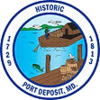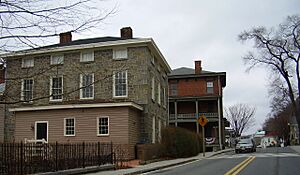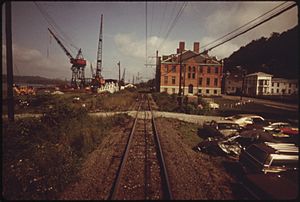Port Deposit, Maryland facts for kids
Quick facts for kids
Port Deposit, Maryland
|
|||
|---|---|---|---|
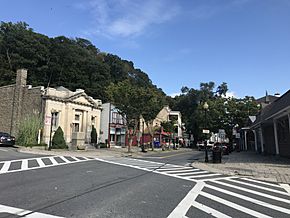
Downtown Port Deposit (2021)
|
|||
|
|||
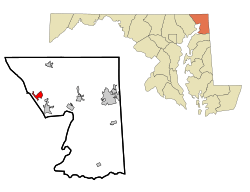
Location of Port Deposit, Maryland
|
|||
| Country | |||
| State | |||
| County | |||
| Incorporated | 1824 | ||
| Area | |||
| • Total | 2.27 sq mi (5.87 km2) | ||
| • Land | 2.26 sq mi (5.86 km2) | ||
| • Water | 0.01 sq mi (0.01 km2) | ||
| Elevation | 49 ft (15 m) | ||
| Population
(2020)
|
|||
| • Total | 614 | ||
| • Density | 271.44/sq mi (104.79/km2) | ||
| Time zone | UTC−5 (Eastern (EST)) | ||
| • Summer (DST) | UTC−4 (EDT) | ||
| ZIP code |
21904
|
||
| Area code(s) | 410 | ||
| FIPS code | 24-63075 | ||
| GNIS feature ID | 0591049 | ||
| Website | http://www.portdeposit.org/ | ||
|
Port Deposit
|
|||
| Lua error in Module:Location_map at line 420: attempt to index field 'wikibase' (a nil value). | |||
| Location | E bank of Susquehanna River 10 mi. (16 km) S of Mason-Dixon Line, Port Deposit, Maryland | ||
| Area | 280 acres (113.3 ha) | ||
| Architectural style | Second Empire, Queen Anne, Georgian | ||
| NRHP reference No. | 78001452 | ||
| Added to NRHP | May 23, 1978 | ||
Port Deposit is a small town in Cecil County, Maryland, USA. It sits on the eastern side of the Susquehanna River, close to where the river flows into the Chesapeake Bay. In 2020, about 614 people lived there.
Contents
- About Port Deposit
- History of Port Deposit
- Early Explorers and Settlements
- The Upper Ferry and Trading Post
- The Susquehanna Canal
- Granite Quarries and Bridges
- Becoming an Incorporated Town
- The Arrival of Railroads
- Jacob Tome's Legacy
- Damming the Susquehanna River
- Other Industries in Port Deposit
- Port Deposit as a Historic District
- Police Department History
- Getting Around Port Deposit
- Population of Port Deposit
- Famous People from Port Deposit
- See also
About Port Deposit
Port Deposit is located in Maryland at these coordinates: 39.610915 degrees North, 76.100172 degrees West.
The town covers a total area of about 2.28 square miles (5.87 square kilometers). Most of this is land, with a tiny bit of water.
It is the westernmost town in Cecil County, Maryland. It is also part of a larger metropolitan area that includes Philadelphia, Camden, and Wilmington.
History of Port Deposit
Early Explorers and Settlements
The first Europeans to visit this area were led by Captain John Smith in 1608 and 1609. He explored the Chesapeake Bay and sailed about 2 miles (3 km) up the Susquehanna River. He named the fast-moving water just above the town "Smythe Fayles."
The Upper Ferry and Trading Post
In 1729, a man named Thomas Cresap started a ferry service. It crossed the Susquehanna River from what is now Port Deposit to Lapidum. This ferry was known as Smith's Ferry or Upper Ferry. Later, Colonel John Creswell bought it, and it became Creswell's Ferry.
This spot was important because it was the farthest north that large boats could travel on the Susquehanna River. River barges and wagons brought goods like lumber, grain, coal, and tobacco downriver. These goods were then moved to bigger ships heading into the Chesapeake Bay. This made it a "port of deposit" for many goods.
By the 1790s, logs from the forests along the Susquehanna were floated downriver to this area. In 1812, the town was officially planned and named Creswell's Landing. A few months later, the governor signed a bill naming the town Port Deposite. Later, the "e" was dropped, and it became Port Deposit.
The Susquehanna Canal
The Susquehanna and Tidewater Canal was finished in 1812. This canal helped the town grow a lot. Before the canal, river traffic often stopped on the other side of the river at Lapidum. This was because it was easier to navigate the rapids from that side. But the new canal on the north side of the river directed all the barge traffic right into Port Deposit. This led to fast growth for the town.
Granite Quarries and Bridges
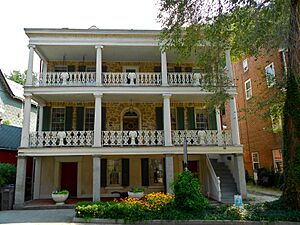
The first attempts to build a bridge over the Susquehanna River in Maryland happened in 1808. The Port Deposit Bridge Company tried but failed. In 1812, another company was allowed to try. The Port Deposit Bridge, a wooden covered bridge, was built just north of Port Deposit between 1817 and 1818. It was the first bridge to cross the Susquehanna River. After a part of it burned in 1823, it was rebuilt and used until 1857.
A 4-acre (1.6-hectare) area at the north end of Port Deposit was used to quarry "granite" (which is actually a type of rock called gneiss). This granite was used to build bridges and many of the unique buildings in Port Deposit today. Quarries also opened here in 1829 to get stone for other canal projects.
These quarries continued to operate well into the 1900s. Port Deposit gneiss was used in many important buildings, including:
- Many houses and five churches in Port Deposit
- Schools like the U.S. Naval Academy
- Forts like Fort McHenry
- Public buildings such as the Boston Public Library and the U.S. Treasury Building
- Public works like the Concord Point Lighthouse
Becoming an Incorporated Town
Port Deposit officially became an incorporated town in 1824. This meant it had its own local government.
The Arrival of Railroads
In 1832, plans were made to connect Baltimore and Philadelphia by railroad. Several railroad companies were formed. Eventually, three companies merged in 1838 to create the Philadelphia, Wilmington and Baltimore Railroad Company. This created a continuous train line from Philadelphia to Baltimore. The main line passed southeast of Port Deposit. A branch line connected the town to the main railroad in 1866.
Jacob Tome's Legacy
Jacob Tome came to Port Deposit with nothing. He became a successful banker, a generous giver, and a politician. He died as one of the richest men in the United States. He was the first millionaire in Cecil County and gave a lot to charity.
In 1889, Tome started the Jacob Tome School for Boys. When he died in 1898, he left a large amount of money to the school. This money helped build beautiful granite buildings for the Tome Institute on the bluffs overlooking the Susquehanna River.
Damming the Susquehanna River
The Susquehanna River drops 167 feet (51 meters) as it flows through the region above Port Deposit. This natural feature, which had helped Port Deposit grow, also attracted power companies after World War I. The Conowingo Dam, built in 1927, greatly changed the town. It stopped all river traffic and severely reduced the fish population, like shad and herring. However, the dam also helped Port Deposit by stopping destructive ice jams that used to form in the river.
Other Industries in Port Deposit
Wiley's Manufacturing was once a major industry in Port Deposit. They built sections of the Fort McHenry Tunnel. These large sections were floated and towed by tugboats to the construction site in Baltimore. Construction finished in 1985.
The immersed tubes for the 63rd Street Tunnel in New York City were also built at a shipyard in Port Deposit. They were then towed all the way to New York.
Port Deposit as a Historic District
The entire town of Port Deposit was added to the National Register of Historic Places on May 23, 1978. This means it is recognized for its historical importance. The historic district stretches about 1.4 miles (2.3 km) along US 222.
The town has many impressive old buildings, often made from local granite or brick. Some of the oldest buildings in the historic district date back to 1725. Most were built between 1830 and the 1890s.
For a long time, the town remained mostly unchanged by new buildings. This was because there wasn't much space between the bluffs and the river. Most of the older buildings are along the main street. The bluffs have been shaped into terraces with stairs connecting different streets. Adams Hall, which was once part of the Tome Institute, is now the Town Hall.
Police Department History
In the second half of the 1900s, Port Deposit had a small police department. Around 1966, Horace Boddy became the chief of police. He was the first African American police chief in Cecil County. Chief Boddy retired from his leadership role in 1980 but stayed on as a patrolman until 1983.
Getting Around Port Deposit
Today, the main way to travel to and from Port Deposit is by road. Maryland Route 222 runs through the center of town along Main Street. It connects north to U.S. Route 1 and south to Perryville and Interstate 95. Both US 1 and I-95 lead to Philadelphia in the north and Baltimore in the south. Maryland Route 276 also serves Port Deposit, heading northeast towards Rising Sun.
Population of Port Deposit
| Historical population | |||
|---|---|---|---|
| Census | Pop. | %± | |
| 1850 | 988 | — | |
| 1870 | 1,839 | — | |
| 1880 | 1,950 | 6.0% | |
| 1890 | 1,908 | −2.2% | |
| 1900 | 1,575 | −17.5% | |
| 1910 | 1,394 | −11.5% | |
| 1920 | 1,090 | −21.8% | |
| 1930 | 963 | −11.7% | |
| 1940 | 883 | −8.3% | |
| 1950 | 1,139 | 29.0% | |
| 1960 | 953 | −16.3% | |
| 1970 | 906 | −4.9% | |
| 1980 | 664 | −26.7% | |
| 1990 | 685 | 3.2% | |
| 2000 | 676 | −1.3% | |
| 2010 | 653 | −3.4% | |
| 2020 | 614 | −6.0% | |
| U.S. Decennial Census | |||
Population in 2010
In 2010, there were 653 people living in Port Deposit. There were 265 households and 153 families. The town had about 288 people per square mile (111 people per square kilometer).
Most of the people were White (82.8%). There were also African American (11.9%), Native American (1.4%), and Asian (0.6%) residents. About 3.2% of the population was Hispanic or Latino.
About 26% of households had children under 18. The average household had 2.39 people, and the average family had 2.89 people. The average age in town was 39.4 years old.
Famous People from Port Deposit
- John Conard (1773–1857) was a member of the U.S. House of Representatives.
- Jacob Tome was a banker and gave a lot of money to good causes.
- Joseph Irwin France (1873–1939) taught at the Tome School and later became a U.S. Senator.
- John A. J. Creswell (born 1828 in Port Deposit) was a U.S. Senator and later the United States Postmaster General.
- James Devereux (1903–1988) attended the Tome School. He was a Marine General and later served in the United States House of Representatives.
- Sarah Collins Fernandis (1863–1951) was a social worker, educator, and poet, born in Port Deposit.
- Admiral Frank B. Kelso II (1933–2013) was a high-ranking officer in the U.S. Navy.
- Clara Dutton Noyes (1869–1936) was born in Port Deposit. She led the Red Cross Nursing Division during World War I and received many awards.
- Martha Tracy Owler (born 1852 in Port Deposit) was a journalist and writer.
See also
 In Spanish: Port Deposit (Maryland) para niños
In Spanish: Port Deposit (Maryland) para niños



